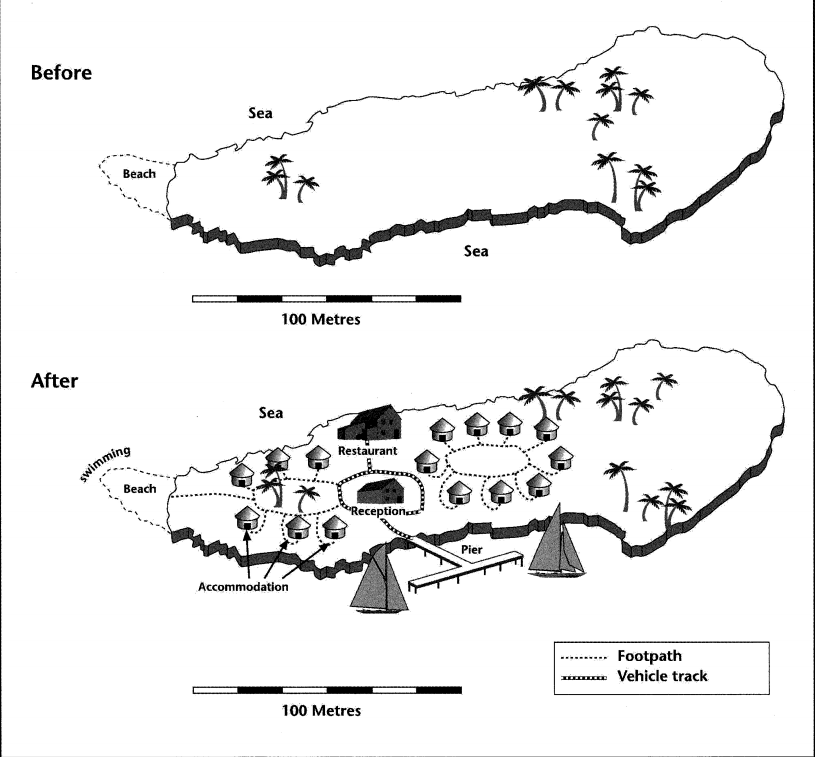
IELTS Academic Task 1: Maps – Island Construction
IELTS Academic Task 1: Island
You should spend about 20 minutes on this task.
The two maps below show an island, before and after the construction of some tourist facilities. Summarise the information by selecting and reporting the main features, and make comparisons where relevant.

Write at least 150 words.
IELTS Writing Version 1: Before and After (Island)
The maps compare the image of an untouched island and the image of the island after the construction of some tourist facilities. Overall, the construction made the island suitable for tourists by providing accommodation and leisure areas.
The 250-meters wide island has a beach on the western side with only a few trees in the middle of the island. Most of the island was inhabitable without any housing or path, and on the eastern side a couple of more trees. After the construction, the beach became a swimming area for the tourist, and footpaths were built from the beach to the side of the island where six accommodations rooms were erected. In the middle of the island, a reception office was built which is connected to the footpath and vehicle tracks. From the reception office, there is a restaurant in the northern part while a pier on the southern part, both connected by a vehicle track. Nine accommodations were erected in the eastern part of the near the reception, and all are interconnected by a footpath while the most eastern part of the island remained untouched.
186 words
IELTS Writing Version 2: Western and Eastern (Island)
The maps compare the image of an untouched island and the image of the island after the construction of some tourist facilities. Overall, the western part of the island was heavily constructed while the eastern part remained as it is.
On the eastern part of the island, there are no man-made changes, only a few added trees and in the middle part there are nine accommodation rooms built in a circular pattern connected by a footpath. In the center of the island, a reception office was erected in which connected by a vehicle path going around the northern part in which a restaurant was built and a pier on the southern part. On the western part of the island, next to the reception is another footpath connecting to six accommodation rooms which were built also in a circular formation. The footpath from the accommodation is extended to the western part of the island where the beach is used for swimming.
162 words
IELTS Writing Version 3: Before and After (Island)
The first map depicts the island without any man-made structures, while the second map displays the constructed island with various facilities for tourism. Despite the eastern part having the largest landmass, the concentration of tourist facilities is focused on the west.
Before the construction, the 250-meter island was an empty space covered by the sea. Most of the trees were located in the eastern part, and there was a beach area in the west. Furthermore, the central part of the island was vacant.
Following the construction, the beach on the western side has been converted into a swimming facility for visitors, complete with a footpath leading to six nipa hut-style accommodations. In the center of the island, there is a reception area that is accessible from both the footpath and a vehicle path. Within the reception area, the northern part houses the restaurant, while the southern part features a T-shaped pier for various activities. On the eastern side of the island, there are an additional nine nipa huts, but these are not connected to either the footpath or the vehicle path.
IELTS Writing Version 4: Western and Eastern (Island)
The two maps of the same island compare the before and after the construction, aimed at catering to tourists. Overall, the western and central parts of the island were significantly commercialized, while the eastern part remained untouched.
While the island lacked man-made facilities before the construction, it underwent a transformation to accommodate tourists after the development. The entrance to the island commences from the southern-central portion, featuring a T-shaped pier where sailboats can anchor, leading to the island’s center where the reception stands. Traveling north from there, a restaurant, with accessibility for cars along this route.
Positioned on the western side of the reception, six accommodations were designed in a nipa hut style, all interconnected through a footpath. Further west, a beach awaits tourists for swimming. Conversely, on the eastern side, there are nine nipa hut-style accommodations, which, notably, remain disconnected from the pathway leading to the reception. Meanwhile, the far eastern section of the island retains its natural, untouched state.
Personal Notes
I recently updated this part as I’ve learned many new techniques for crafting a well-structured answer. My intention is for readers to comprehend that writing enhances your capacity to identify flawed or improved writing in the future. I didn’t specifically concentrate on expanding my vocabulary; rather, I prioritized delivering answers as effectively as possible. You may notice that I didn’t utilize an excessive number of words, yet it’s evident that it’s feasible to compose a response with a concise 150+ words while maintaining clarity and coherence.
My Rules
Here are my personal rules when it comes to writing test 1. I wouldn’t claim that I meet all these criteria perfectly. However they serve as a guideline for me to ensure I produce a satisfactory response:
Task 1:
1. Aim to write approximately 160 to 190 words.
2. Your essay should consist of 6 to 8 sentences in total.
3. Structure your essay into three paragraphs:
a. Paragraph 01: 35 to 40 words
i. One sentence for the introduction.
ii. One sentence for the overview.
b. Paragraph 02:
i. Two to three sentences only (ranging from simple to complex).
c. Paragraph 03:
i. Two to three sentences only (ranging from simple to complex).
4. Do not include a conclusion.
5. Use only “Overall” or “In general” in your overview.
6. Avoid using words you are not familiar with.
7. Provide facts only; do not include any personal opinions.
8. Imagine that the examiner cannot see the image; provide a clear description, avoiding vague expressions.
9. If you need to replace a word, ensure it is at the same complexity level or higher.
10. Avoid adding unnecessary words to lengthen your essay. If the examiner can remove a word, and the idea remains unchanged, it is unnecessary.
Check other IELTS writing
Check my blog

Ian Tanpiuco is an ESL and virtual assistant. With a decade of experience, he has become an expert in his field. Dedicated to helping others achieve their goals, Ian works tirelessly in the classroom or as a virtual assistant.

